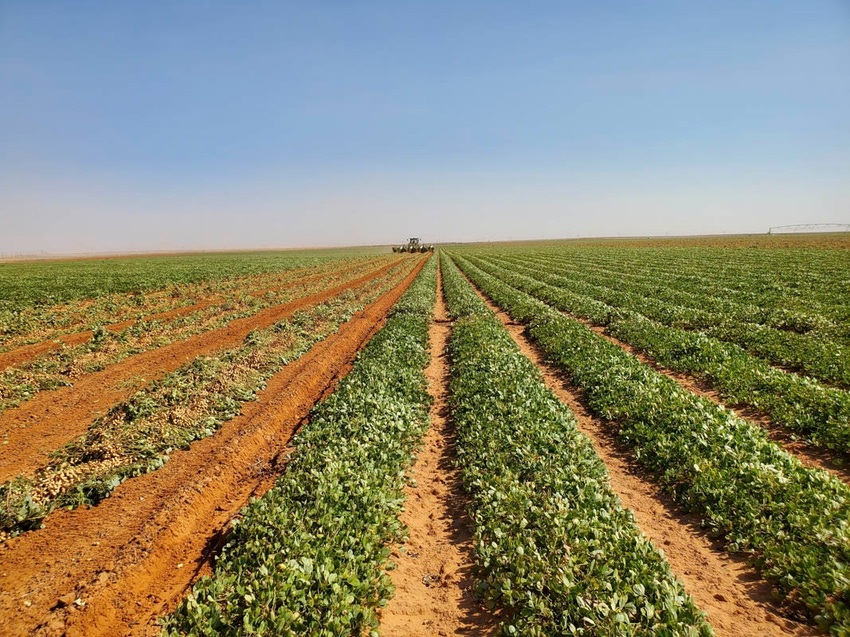
Aflatoxin takes as much as $126 million out of the U.S. peanut industry each year and may be responsible for significant losses even in years with low aflatoxin contamination rates.
“Aflatoxin in U.S. peanuts is a major economic problem,” says USDA National Peanut Laboratory Research Lead Marshall Lamb.
 USDA National Peanut Laboratory Research Lead Marshall Lamb (Photo by Shelley E. Huguley)
USDA National Peanut Laboratory Research Lead Marshall Lamb (Photo by Shelley E. Huguley)
Lamb, speaking at the recent (virtual) American Peanut Research and Education Society (APRES) annual meeting, said all segments of the industry spend millions, “sometimes hundreds of millions) of dollars annually to ensure consumer safety.
“Aflatoxin and Aspergillus negatively impact all segments of the peanut industry,” Lamb said.
A study dating back to the 1990s (’93-’96) put aflatoxin costs at around $26 million per year. That study showed the pathogenic fungus costing the industry $24 per ton, and $28 per acre.”
Lamb said the peanut industry felt a new study was needed to develop current estimates on the costs of aflatoxin in peanuts. “We conducted a new three-year study in the 2017, 2018, and 2019 crop years,” he said.
See, A plant pandemic: 'Plants get sick, too'
The study was a “double-blind confidential survey (very comprehensive and detailed)” to obtain data such as: buying point testing cost, farmer stock purchases, sheller stock outturns, sheller stock price, oil stock price, farmer stock and sheller stock testing cost, equipment, failed lots, re-milling and/or blanching (cost and loss), labor and management, and many other losses.
“The surveys accounted for 72% of all U.S. peanut production during the three-year period.”
2019 was a particularly bad year for aflatoxin, the study shows, with a 29.5% fail rate, assessed after shelling and sorting.
Key survey findings show 2017 was a relatively light aflatoxin year. Of 1.8 million harvested acres across the United States, yield averaged just a tad more than 4,100 pounds per acre. Cost to aflatoxin that year from costs to segregation of contaminated farmer stock peanuts included $20.7 million in total losses, $11.60 per acre and $5.90 per ton.
In 2018, with a 1.4 million-acre harvested crop, and a 4,000 pounds-per-acre average yield, seg-related farmer stock aflatoxin costs included $18.5 million in total costs and $13.52 per acre and $6.83 per ton.
Aflatoxin took a big chunk out of 2019 farmer stock peanut revenues. With 1.4 million harvested acres, and a 3,934-pound average yield, seg-related aflatoxin costs totaled $27.1 million. Per acre cost was $19.61, and per ton cost was $10.07.
Averages across the three years include $22.1 million total costs, $14.91 per acre and $7.60 per ton.
Losses continued beyond the farm gate. Shelled stock losses, including costs for remilling, blanching, diversion to lower value usage, product losses and other issues, also total into the millions.
Total shelled stock losses in 2017 were around $10 million. In 2018, the cost increased to $12.2 million and jumped to $47.6 million in 2019. Per acre costs for those three years were, consecutively, $5.60, $11.66 and $34.26. Cost per ton was $2.85, $5.89, and $17.60. Average total cost for the three years equaled $23.3 million.
Remediation also takes a toll. Total cost to remedy failed lots after shipment totaled just under $1 million in 2017, $1.1 million in 2018 and $6.1 million in 2019. Average for the three years is $2.7 million.
The bottom line for all costs shows a whopping $126.2 million cost for the 2019 crop. Loss in 2018 was $68 million and $58 million in 2017. Average for the three years comes to $84.1 million.
The survey indicates the cost of aflatoxin has increased precipitously since the 1990s.
“Aflatoxin in U.S. peanuts imposes significant economic stress to the U.S. peanut industry,” Lamb says. “Even in low aflatoxin years, a significant amount of money is spent just due to the ‘potential’ of aflatoxin.”
He says the industry incurs these costs every year so that U.S. peanuts will meet final product quality standards.
“Eliminating or significantly reducing aflatoxin would improve the competitiveness of U.S. peanuts.”
Read more about:
AflatoxinAbout the Author(s)
You May Also Like






